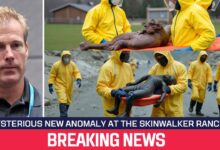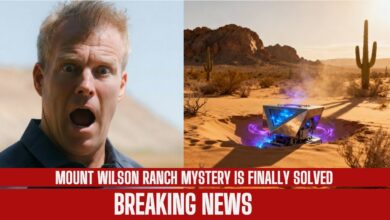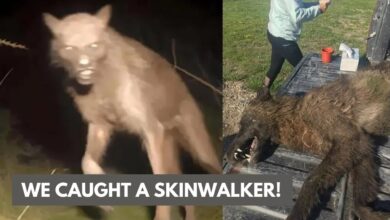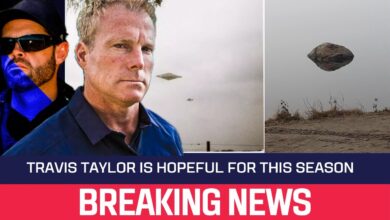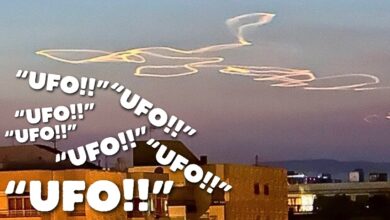Travis Taylor – “This could be an Alien Base!”
Travis Taylor - "This could be an Alien Base!"

In the heart of Utah’s remote Uinta basin, the infamous Skinwalker Ranch continues to serve up phenomena that defy logic, science, and sometimes even belief itself.
For decades, the ranch has been the epicenter of sightings, electromagnetic anomalies, and unexplainable events.
But a recent chapter in the investigation led by astrophysicist Dr. Travis Taylor has taken a deeply disturbing turn.
What began as a routine drilling operation into the enigmatic Rocky Mesa has now spiraled into a chain of discoveries that read more like the plot of a science fiction thriller than a scientific field report.
The team’s mission was simple on paper. Penetrate the mesa to retrieve data and collect samples.
But almost immediately, the drill struck something unexpected. A strange green jellylike substance oozing from the borehole.
Laboratory analysis hinted at an organic composition. Yet, its chemical structure didn’t match any known biological material on record.
Some samples even contained trace isotopes found in meteorites, raising the unsettling possibility of an extraterrestrial origin, or something ancient that has been sealed away for millennia.
Beneath that layer lay something even more perplexing.
Structural anomalies that radar imaging couldn’t fully explain.
The subsurface scans revealed hard, sharply defined edges and surfaces that contrasted starkly with the random jagged fractures expected in natural rock formations.
These patterns suggested deliberate construction—walls, arcs, even what looked like ribbed plating intombed beneath tons of sandstone.
Since 2021, the investigative team has been obsessed with one particular reading, a massive dome-shaped anomaly buried deep inside the mesa.
Ground penetrating radar revealed that this formation was composed of metallic material with unusual electromagnetic properties.
Properties eerily similar to the multi-layered shielding NASA uses to protect spacecraft from extreme radiation in deep space.
Even more baffling, this object seemed to absorb and scatter radar waves in ways no known terrestrial alloy should, rendering portions of it effectively invisible to certain scanning frequencies.
Multiple attempts to reach the anomaly have been thwarted. Drilling rigs have experienced sudden power failures.
Bits have snapped clean off under pressures far below their rated tolerance.
Sensors have overheated without warning.
In several cases, the crew has reported hearing deep, resonant booms from inside the mesa, like something shifting in the darkness below.
Now, with every new core sample and radar sweep, the evidence points to the same chilling conclusion.
There is something beneath Rocky Mesa that does not belong there.
Whether it’s a buried craft, an ancient underground facility, or a fragment of a technology so advanced it appears alien, one fact is undeniable.
The mesa is hiding more than just stone.
Over the past month, the team shifted tactics, determined to outmaneuver whatever force or technology had kept them from reaching the heart of Rocky Mesa.
This time, they deployed a dual drilling strategy. Two 8-in bore holes sunk in parallel, flanking the suspected dome structure.
The plan was simple in theory: insert high-resolution imaging probes and advanced spectroscopic scanners from opposite sides to triangulate the object’s shape, composition, and internal structure.
In execution, however, the operation veered quickly into the realm of the unnerving.
Almost from the moment the drill bits breached the critical depth zone, reality seemed to twist.
The underground beacon, a hardened tracking device used to monitor the drill’s position with pinpoint accuracy, began to behave erratically.
Readouts flickered between wildly inconsistent coordinates.
One moment the drill appeared to be directly on course.
The next it was shown hundreds of feet off target.
At times the beacon would vanish entirely from the monitoring screens only to reappear seconds later with corrupted or nonsensical data.
The engineering crew initially suspected a mundane cause—interference from mineral deposits perhaps, or a calibration glitch.
But as the anomalies mounted, it became harder to ignore the feeling that this was no ordinary signal disruption.
The scrambling wasn’t random. It was patterned, almost purposeful, like the signature of a jamming device designed to repel any attempt to probe deeper.
“I have no idea where this drill head is right now,” admitted one of the drillers, his voice tight with unease.
The word sent a chill through the control tent.
They were, for all practical purposes, blind.
Blind in one of the most mysterious and, according to countless accounts, most dangerous areas on the ranch.
The unease only deepened when the team turned their attention to the spoils pit, the containment area, where material from deep within the mesa was deposited.
Shoveling through the freshly extracted debris, they spotted something that stopped them cold.
Amid the powdered sandstone and fractured rock were fragments unlike anything naturally formed, slender shards of a metallic alloy that shimmered faintly even under the harsh glare of worklights.
Some were unnervingly smooth, others etched with geometric grooves that looked almost machined.
When tested with a handheld magnetometer, several pieces produced magnetic fluctuations that didn’t align with any known ferris signature.
The question was immediate and haunting.
Had they just uncovered a piece of the dome itself, or something far stranger among the jagged shards of sandstone and clumps of iron-rich clay?
Ranch security chief Brian Arnold, known across the investigation as Dragon, spotted something that didn’t belong.
A dull, mossy green lump, no bigger than a fist, sat half buried in the slurry at the edge of the spoils pit.
At first it seemed like an odd mineral inclusion, maybe a chunk of serpentine or weathered copper ore.
But when Arnold picked it up, everything changed.
The moment his fingers closed around it, the stone yielded with an unsettling give, compressing slightly before springing back into shape.
It was cool to the touch, cooler than the surrounding rock, as if it had been insulated deep underground.
The surface shimmered faintly under the portable work lights, a wet, almost iridescent sheen playing across its contours.
He gave it a gentle squeeze.
The lump distorted under pressure like dense gelatin.
No grit, no crystalline structure, no granular breakage.
Whatever this was, it was not a rock.
“That’s the strangest thing I’ve seen,” Dr. Travis Taylor muttered as he crouched down beside Arnold, his brow furrowing.
He lifted a sample with a pair of nitrogloved hands, rotating it in the light.
“Tiny bubbles, air pockets, or perhaps something else, seemed suspended within the material, refracting light into faint rainbows.
This shouldn’t even be here,” he said.
“Not at this depth.”
More fragments emerged as the team sifted through the drill debris.
Some were deep green, others modeled with faint pink and violet streaks that seemed to swirl within the mass rather than sit on the surface.
Several pieces were strangely uniform in shape, as though they had been molded or grown in a controlled environment.
When probed with a steel pick, the substance resisted penetration for a moment before parting cleanly, revealing an even more vibrant coloration inside and a faint metallic tang in the air like ozone after a lightning strike.
The texture inside was uniform, lacking any sign of natural sediment layering.
Theories flew around the site.
Could this be ancient biological matter, perfectly sealed in an oxygen-deprived environment for millennia?
Some kind of resin or polymer, possibly synthetic, buried intentionally, or was it the remnant of something far stranger, an organic, inorganic hybrid designed for a purpose unknown?
Taylor glanced back toward the bore hole, his expression grim.
“If this came from near that dome, then we might not just be drilling into rock. We might be cutting into something,” he said.
And with that, the team realized this green gelatinous mass wasn’t just a curiosity.
It could be a clue.
One more piece of an expanding puzzle that was starting to suggest something beneath Rocky Mesa was deliberately placed there.
If the green gelatinous mass had set the team on edge, what came out of the bore hole next sent their minds spiraling into new territory.
While sifting through the damp stone-flecked debris, one of the crew spotted a small splintered fragment protruding from a clump of drill cuttings.
At first glance, it looked like a shard of aged wood, weathered, pale, and fibrous.
But as soon as it was rinsed off under the portable wash station, it revealed a smoother surface, almost polished in places, as if it had once been shaped by human hands or machinery.
“That’s not tree root,” someone muttered.
Brian “Dragon” Arnold held it up to the worklights, turning it slowly.
It had an odd symmetry, subtle, but enough to suggest it had been cut, not broken.
“How the hell did this get inside the mesa?” one team member asked, voicing what everyone was thinking.
The immediate theory was an old mine shaft or abandoned man-made tunnel.
But a quick check of historical records showed nothing.
No mines, no excavation permits, no evidence of any such structure.
Certainly not that deep, and certainly not carved into solid sandstone.
The mesa was supposed to be untouched, geologically sealed for countless centuries.
And yet, here it was, proof of something anomalous, lying hundreds of feet underground.
Dr. Travis Taylor wasn’t willing to settle for speculation.
He carefully sealed the fragment in a sterile container and sent it along with the green gelatinous samples to Dr. Power, a material specialist at the University of Utah.
If anyone could determine its origins, it was him.
When the results came back, the mystery only deepened.
Using high-resolution scanning, electron microscopy, and spectral analysis, Dr. Power determined the fragment was not wood in the traditional sense.
In fact, it wasn’t wood at all.
The cellular structure revealed it to be the stem of an aquatic plant, something that had once grown in a wet, possibly marsh-like environment.
The room fell silent when Dr. Taylor read the report aloud.
An aquatic plant sealed inside the sandstone heart of Rocky Mesa.
No rivers, no lakes, no wetlands, no plausible geological pathway for it to have drifted here naturally.
If the mesa had never been submerged, at least not in any known epoch, then the only explanations left were the kind that made the hair rise on the back of your neck.
“These pores suggest it’s likely from a spore-producing plant, probably aquatic,” Dr. Power explained, tapping at the magnified cellular image on his monitor.
That one detail landed like a stone in the room’s silence.
An aquatic plant buried in the heart of a mesa that according to every geological survey had never been a wetland.
The surrounding rock was arid sandstone and clay, the kind formed in a dry wind-scoured landscape.
The science didn’t match the find, but the shock was only beginning.
The green jelly, arguably the strangest of the borehole discoveries, was placed under high-resolution microscopy.
The team half expected to see algae-like filaments or chlorophyll structures dancing under the lens.
Instead, the image revealed nothing of the sort.
Its vivid emerald color wasn’t biological at all.
It wasn’t plant matter.
It wasn’t algae.
It wasn’t even alive.
Intrigued, Dr. Power subjected the substance to a chemical wash.
The green bled away, dissolving like ink in water, only to reveal something even stranger.
What remained at the bottom of the petri dish was a dense concentration of charcoal, burnt plant matter.
But this wasn’t from the surface.
This wasn’t from a forest, fire, lightning strike, or campfire.
This charcoal was embedded in the geological strata deep inside the mesa in layers that should have been untouched for thousands if not millions of years.
“You mean something caused a fire deep inside the mesa?” Dr. Taylor asked, leaning forward.
“Absolutely,” Dr. Power confirmed, his tone cautious but certain.
The revelation cracked open a host of unsettling possibilities.
Was it ancient volcanic activity, something unrecorded in the local geological history?
Or could it have been the result of something far stranger?
An explosion from an unknown event, a crash, or as some on the team dared to whisper, the ignition of a propulsion system belonging to a now buried craft, possibly one not built on Earth.
The mesa was no longer just a geological curiosity.
It was starting to look like the scene of an ancient incident, one that had been sealed away, waiting to be uncovered.
This wasn’t the first time strange electromagnetic or geophysical anomalies had been recorded at Skinwalker Ranch.
For decades, the property had been a stage for the bizarre—unidentified aircraft darting across the skies, cattle mutilation so precise they bordered on surgical impossibility, poltergeist-like disturbances that terrorized residents, and sudden unexplainable health episodes that struck researchers in the middle of their work.
But what was happening inside Rocky Mesa felt different.
This was not just flickering lights in the distance or shapes glimpsed through night vision scopes.
This was tangible, physical, verifiable, and if the implications were true, utterly unprecedented.
The combination was almost too strange to dismiss.
A massive metallic dome hidden deep in the mesa, advanced enough to mimic the properties of NASA’s spacecraft shielding, electronic equipment going haywire the closer it came to the anomaly, bizarre jelly-like material with no known biological origin, fragments of ancient aquatic plants somehow charred in a place where fire should never have existed.
Each find by itself was strange.
Together they painted a picture of something profoundly unnatural.
It was hard to ignore the most unsettling possibility that something had crashed here long ago.
Something advanced, perhaps not of this earth, something that didn’t simply vanish into the sands of time, but was buried either by natural processes or by deliberate calculated concealment.
If that theory was true, the mesa wasn’t just a geological formation.
It was a tomb.
“This could be a debris field,” Dr. Taylor murmured, his voice carrying the weight of a possibility no one wanted to say out loud.
“We may be looking at the evidence of an ancient impact or a coverup.”
The air around the drilling site felt heavier, almost oppressive, as though the mesa itself was aware of their intrusion.
What began as a straightforward borehole operation had transformed into a battle against the land.
Perfectly functional drills suddenly bucked and locked without warning.
Compass needles didn’t just point the wrong way.
They jittered violently, like something beneath the ground was pulling at them.
On multiple occasions, radiation detectors chirped wildly, only to drop back to baseline seconds later.
No known geological feature could explain such sudden localized spikes.
One moment, the reading suggested a harmless environment.
The next they hinted at dangerous exposure.
And then there was the toll on the team.
Veterans who had worked on high-stake sites around the world now found themselves dizzy, short of breath, or momentarily unable to recall basic operational steps.
One technician, sweat pouring down his temples, gripped the drill control so tightly his hands trembled.
The underground tracking signal had begun to dance erratically, jumping dozens of feet in an instant before vanishing entirely.
“I have no idea where this drill head is right now,” he admitted, his voice taut with frustration and unease. The words fell over the group like a cold shadow.
“What the hell is in that mesa?” Another voice called out from behind, breaking the tense silence.
No one answered. They all knew the stories of glowing orbs that streak silently across the night sky, of strange creatures spotted just beyond the tree line, of unexplained injuries and violent poltergeist-like episodes.
Now, those stories didn’t feel like folklore. They felt like a warning. The closer they got to the dome-shaped anomaly, the more the environment seemed to shift. Lights from the equipment took on a faint shimmer in the air, almost like heat distortion. Even though the night was cool, a low-frequency hum, too deep to be a machine, was reported by two team members, though no recording equipment picked it up.
Nobody said it aloud, but the fear was there. Whatever they were uncovering might not simply be inert debris. It might react. And if it did, there was no telling what they would be dealing with. Ancient technology, interdimensional phenomena, or something far stranger.
Whether Rocky Mesa concealed the remnants of a lost civilization, the ruins of a classified military project, or a craft that fell from the sky long before humans walked the Earth, one thing was certain. This was no ordinary discovery. The Mesa was guarding its secrets with a stubborn, almost intelligent resistance. And the deeper they drilled, the more it seemed to fight back.
The evidence emerging from this strange chapter in the Rocky Mesa investigation is more compelling and more disturbing than anything the team has yet encountered.
Dr. Travis Taylor, standing at the edge of the borehole as the evening sun bled into the desert horizon, made it clear they weren’t backing down. The fear was real, the unanswered questions mounting, but so too was their resolve.
The strange green jelly that defied geological explanation. The aquatic plant stem locked in stone that should have been dry for millions of years. The scorched biological remnants hinting at fire or explosion deep within the mesa. These were no longer just curiosities. They were fragments of a much larger, unfathomable puzzle. A puzzle that might rewrite everything they thought they knew about the land, its history, and perhaps even its place in the universe.
But the closer they got, the stranger the possibilities became. The notion that the dome-shaped anomaly might be nothing more than buried machinery or debris now felt too simple.
As the team replayed years of collected data — electromagnetic interference that disrupted every kind of sensor, bursts of radiation appearing and vanishing like phantom signals, even physical ailments that struck healthy crew members without warning — they began to confront an unsettling idea.
What if the anomaly wasn’t just buried? What if it wasn’t even fully in our reality?
There was growing talk quietly traded between researchers that whatever lay beneath the mesa might not obey the physical rules they were accustomed to. Could it be connected to an interdimensional presence? Something capable of bending electromagnetic fields, corrupting signals, and exerting physical effects on those nearby?
The thought alone was unnerving, but it wasn’t without precedent. Skinwalker Ranch had a long and chilling history of such phenomena.
Researchers over the decades had described glowing aerial craft that could accelerate from a dead stop to blinding speeds in an instant. Strange creatures, some humanoid, others grotesquely unfamiliar, had been reported stalking the perimeters. More than one investigator had left the property with unexplained burns, dizziness, or cognitive disorientation.
Now, as the drill pushed ever deeper into Rocky Mesa, it felt like they were approaching the epicenter of it all. The location where the geological, the technological, and the supernatural might converge.
And that left one question hanging heavy in the desert air. Not what lies buried beneath the mesa, but whether the world is prepared for what happens when it’s finally brought to light.
These phenomena don’t seem to happen everywhere on the ranch. They cluster almost deliberately in certain hot spots, and none is more potent than the area surrounding Rocky Mesa.
It’s as if something unseen lurks there, a threshold of sorts, waiting for the right conditions or the right intrusion to awaken it. Some on the team whisper about it like a legend. Others discuss it in the language of theoretical physics. But the implication is the same.
There may be a boundary in that rock. Could the erratic drill beacons, the inexplicable equipment failures, and the electromagnetic chaos be the telltale signs of crossing an invisible frontier? One embedded deep in the mesa’s core.
Dr. Travis Taylor, cautious in his public statements, has nonetheless been exploring a theory that sounds like pure science fiction: that Rocky Mesa may conceal a space gate, an ancient or artificially engineered wormhole-like construct capable of bending both space and time.
The implications are staggering. The dome-shaped anomaly could be more than just a buried object. It could be a key component of a machine or a natural geological turned engineered structure designed to manipulate energy on a scale we can barely measure.
Magnetic distortions, localized radiation spikes, discrepancies in time itself, where instruments or even people experience missing seconds or minutes without explanation.
Such a device, if it exists, could explain more than just the green jelly and strange plant remains. It could account for the phantom aircraft that vanish mid-flight, for bizarre creatures that appear for moments before melting back into the night, for the sensations some witnesses describe of being watched by something that isn’t there.
Perhaps these are not visitors arriving from the sky at all, but travelers emerging through a rift in the fabric of reality itself, passing briefly into our world before returning to wherever they came from.
It’s a notion that eerily mirrors the ancient lore of the region. Long before Skinwalker Ranch became the subject of modern investigation, the Ute people spoke of this land as cursed, a place where shape-shifting beings, the Skinwalkers, could manifest at will, moving between forms and slipping between worlds.
They avoided the Mesa and its surroundings, not out of superstition, but out of respect for forces they understood in ways our science still struggles to define.
Now, as modern drilling rigs and high-tech sensors bite into the mesa’s ancient body, the team can’t help but wonder if they are not merely investigating history, but actively disturbing it.
These ancient accounts, so often waved away as superstition, now seem disturbingly plausible when weighed against the team’s modern discoveries.
The gelatinous green substance with its alien chemistry and the charred aquatic plant material locked in solid sandstone may not be random geological oddities at all. They could be residues, traces left by something non-human, perhaps even non-corporeal that passed through our world or interacted with it in ways we still have no framework to understand.
What if the skinwalkers of legend were not simply shape-shifting shamans, but manifestations of transdimensional beings, creatures that could enter and exit our physical reality at will?
Once such ideas were relegated to science fiction or whispered myths. Now, they’re being logged, measured, and analyzed as legitimate lines of scientific inquiry.
But perhaps the most chilling possibility of all is this. What lies under the mesa may not be a wreck, a relic, or a dormant machine. It could be a vault, a containment system, something intentionally designed, whether by human hands or an intelligence far beyond ours, to hold or quarantine an entity, a technology, or a phenomenon too dangerous to be released.
The strange dome-like structure, the electromagnetic distortions, the pockets of scorched biological matter. Together, they could be evidence of a security system on a planetary scale.
The signs of extreme heat or combustion embedded deep in the rock might not be the result of an accident or natural process at all. They could be the scars of a battle to seal something away, a desperate act of isolation meant to last for centuries or longer.
If that’s true, then drilling deeper isn’t just risky. It may be the equivalent of breaking a lock that was never meant to be opened.
There’s a growing unease among the team, a quiet but persistent fear that the drill may have already crossed an invisible threshold, awakening or disrupting a system that was never meant to be touched.
The question gnaws at them during long nights on the ranch: have we already gone too far?
If the strange structures and residues beneath Rocky Mesa are part of an ancient containment or gateway, then perhaps others long before them had discovered it, too.
The idea sparks unsettling speculation. Were ancient civilizations aware of what slept under the sandstone? Did they try to seal it away, leaving warnings that time has since eroded into myth? Or more disturbingly, have there been modern attempts to breach it? Attempts that failed, leaving no official record?
For those versed in the darker lore of Skinwalker Ranch, this thought dovetails into decades of conspiracy theories.
Whispers persist that the ranch is not merely a hot spot of paranormal activity, but a piece of a much larger classified research zone. A place where the US government or forces beyond even governmental oversight have tested the limits of human understanding.
Allegations range from psychological warfare programs and experimental propulsion systems to exotic energy weapons and even time manipulation technology.
If any of those rumors hold even a kernel of truth, then the anomalies detected in the mesa, the magnetic distortions, the bizarre biological remnants, the dome-like structure, could be the aftermath of those experiments, or the very reason they were conducted here in the first place.
The most disturbing possibility isn’t just that the team is digging into something alien, but that they’re tampering with unstable reality itself.
Some researchers have quietly theorized that time may behave differently here, warping under the influence of whatever energy pulses through the rock. Could the strange creatures spotted on the property, beings that vanish in an instant, be visitors from other eras, or even parallel timelines?
Perhaps they’re echoes of futures that haven’t yet arrived, or ghosts of a world that was never meant to be.
If so, then the drilling isn’t just a scientific endeavor. It’s the turning of a key in a lock whose purpose we don’t yet understand. And once that lock is opened, there’s no way to close it again.
As wild as these theories sound, they are no longer being dismissed as fringe speculation. The hard data — spectroscopic readings, radiation spikes, magnetic distortions — stubbornly refuse to align with any conventional geological or environmental explanation.
The deeper the scientists dig, the more the evidence forces them toward a crossroads where fact and impossibility intersect.
What’s unfolding at Skinwalker Ranch is no longer a matter of simple paranormal investigation or even daring archaeological exploration.
This is cutting-edge science venturing into a realm where the known laws of physics blur into something uncharted.
Here, the precision of laboratory analysis collides head-on with the ancient whispers of mythology. Biology, cosmology, folklore, and advanced physics all seem to swirl together in one volatile, enigmatic cauldron.
And nowhere is this collision more pronounced than deep beneath Rocky Mesa.
For the first time, the scientific community and the public may be staring at a case that demands a radical shift in perspective.
The work here cannot be done by skeptics sniping from the sidelines or by thrill-seekers looking for campfire ghost stories. It requires investigators willing to abandon their intellectual comfort zones to accept the possibility that reality itself may be far stranger than we’ve been taught.
If what lies beneath Rocky Mesa truly is the wreckage of a craft not of this earth, the remains of a living organism unlike anything in the fossil record, or most staggering of all, a constructed gateway into another dimension, then we are standing at the threshold of a discovery that could rewrite human history.
Such a revelation would ripple through every field of study, from astrophysics to anthropology, forcing us to confront truths we may not be ready to hear.
One drill hole at a time, the team edges closer to an answer. But with each layer of rock stripped away, they are not just excavating a mystery. They may be dismantling the boundary between our world and something far older, stranger, and more powerful than we’ve ever imagined.

